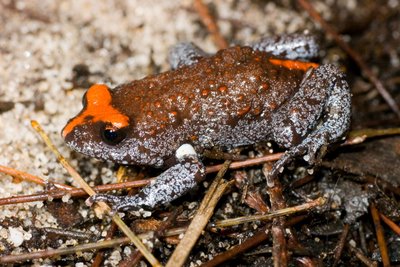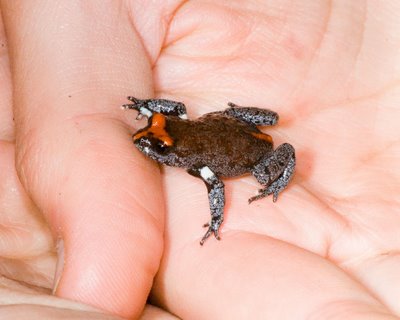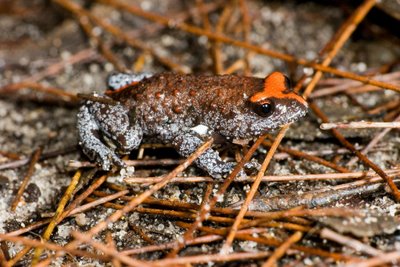 Most frogs breed in spring and summer, though in a country like Australia there's a fair bit of uncertainty about when the rain will fall, if at all, so a lot of frogs are pretty opportunistic. Some frogs will breed only in winter however, for example the Jervis Bay Treefrog (Litoria jervisiensis). This strategy always seems pretty crazy to me. Frogs don't regulate their body temperature physiologically, and it's surprising to me at least that winter-breeders manage to have enough energy to call at low temperatures. Then there's the investment that spawning takes! Winter is a time to save your resources, not chuck them in a pond! You rarely see most snakes and lizards in winter, but these frogs are at their most conspicuous at these times! Forgive my rant, it's just that these little squishy frogs are made of much sterner stuff than a lot of people would think. Oh, one last example. Another winter-breeding treefrog, Litoria littlejohnni (not named after our PM, BTW, but Murray Littlejohn), has been recorded down at Barren Grounds calling at just three degrees above zero!
Most frogs breed in spring and summer, though in a country like Australia there's a fair bit of uncertainty about when the rain will fall, if at all, so a lot of frogs are pretty opportunistic. Some frogs will breed only in winter however, for example the Jervis Bay Treefrog (Litoria jervisiensis). This strategy always seems pretty crazy to me. Frogs don't regulate their body temperature physiologically, and it's surprising to me at least that winter-breeders manage to have enough energy to call at low temperatures. Then there's the investment that spawning takes! Winter is a time to save your resources, not chuck them in a pond! You rarely see most snakes and lizards in winter, but these frogs are at their most conspicuous at these times! Forgive my rant, it's just that these little squishy frogs are made of much sterner stuff than a lot of people would think. Oh, one last example. Another winter-breeding treefrog, Litoria littlejohnni (not named after our PM, BTW, but Murray Littlejohn), has been recorded down at Barren Grounds calling at just three degrees above zero!Time to cut to the chase, I think. The frog I was after two weeks ago isn't really a winter-breeding frog, but atypically, more of an all-year-round frog. It's the Red-Crowned Toadlet, Pseudophryne australis. This species is pretty special in many aspects. It's a very relevant frog to Sydneysiders as it is tightly linked to the Hawkesbury sandstone of the area and isn't found outside the greater Sydney Basin. It's a striking frog, like many Pseudophryne species (the genus includes the two species of stunning Corroborree frogs), and its colouration hints at its toxic nature. That red that looks so obvious doesn't actually make the frog that noticeable, however, as wet fallen Eucalyptus leaves that make up the leaf litter it inhabits often show a similar colour.
 This little frog is believed to have declined quite considerably from the numbers it once existed in. A large part of the story of its decline is probably urbanisation. Building, clearing, pollution, bush-rock removal - the same tale of a lot of Sydney's declining wildlife. I quote Richard Wells (2002), a herper in Sydney, describing his experiences with this frog from 1965:
This little frog is believed to have declined quite considerably from the numbers it once existed in. A large part of the story of its decline is probably urbanisation. Building, clearing, pollution, bush-rock removal - the same tale of a lot of Sydney's declining wildlife. I quote Richard Wells (2002), a herper in Sydney, describing his experiences with this frog from 1965:"They were just so common that I thought that everything about their life history would have been long ago recorded and usually I just about ignored them"
Jump forward to the present:
"...the little frog I found once so commonly 35 years ago is now thought by some to be at risk of extinction. If someone had told me that this could happen to that species back in 1965 I would have laughed in their face."
A sobering tale. This species really appears to live life on the edge, and in more ways than one. Some recent work by Karen Thumm for her PhD (supervised by Mike Mahony) had some interesting findings and implications for the natural history of the frog. Basically, after the frog oviposits (the clutch is laid on land in moist leaf-litter, then when the tadpoles hatch they develop further in small pools), the eggs within a single brood take a variable amount of time to hatch, and tadpoles hatch at various stages of development. Why? The hypothesis is that the frog is 'bet-hedging' in the face of Sydney's particularly unpredictable rainfall (Thumm & Mahony 2002).
 "Rain does not fall in a wet season or in any predictable pattern in the Sydney Basin. The advantage or disadvantage of delaying hatching depends on unpredictable future rain conditions.A strategy for optimal hatching times cannot evolve. If all embryos hatched at the same time, there would be a high chance of total reproductive failure. It appears that in the absence of a clear environmental signal, hatching is staggered in order to spread risk."
"Rain does not fall in a wet season or in any predictable pattern in the Sydney Basin. The advantage or disadvantage of delaying hatching depends on unpredictable future rain conditions.A strategy for optimal hatching times cannot evolve. If all embryos hatched at the same time, there would be a high chance of total reproductive failure. It appears that in the absence of a clear environmental signal, hatching is staggered in order to spread risk."I've done a bit of a hopeless job of explaining very much about this frog, but this post is long enough already, so I recommend you read some of the below sources. Or I may blog about it again in the future.
References and further reading:
Thumm, K. & Mahony, M. (2002). Hatching dynamics and bet-hedging in a temperate frog, Pseudophryne australis (Anura: Myobatrachidae). Amphibia-Reptilia 23, 433-444.
Wells, R. (2002). Notes on the Red-crowned Toadlet Pseudophryne (Pseudophryne) australis (Gray, 1835) - an endangered frog from the Sydney Basin of New South Wales. Australian Biodiversity Record (4), 1-28. Link (well worth a read): http://forum.kingsnake.com/tax/messages/1027.html
Red-Crowned Toadlet Threatened Species information at National Parks: http://www.nationalparks.nsw.gov.au/PDFs/tsprofile_redcrowned_toadlet.pdf




1 comment:
Stunning photos and very informative text.
Post a Comment